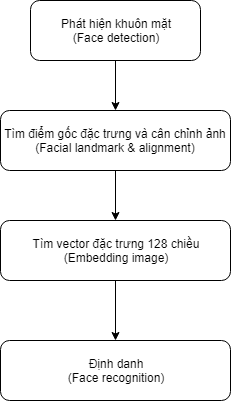This is case study in Pattern recognition subject. We study Face Recognition At a Distance (FRAD) but there are a lot of challenges such as: Optics and Light Intensity, Exposure Time and Blur, Image Resolution and Pose, Illumination and Expression. Also, FRAD need to set up a system that has several cameras like wide field of view (WFOV) and narrow field of view (NFOV). This project is based on this article [1].
Rigorous reports for FRAD: FRAD_report.pdf and FRAD_representation.pptx.
There are 2 demos:
- Demo1: It used for presentation at class. We trained model with small dataset. We used Single Shot Detector (SSD) model with ResNet architecture for detecting object. For more details, please check out our report at DEMO-1-Report.pdf.
- Demo2: We improved the performance for face detection at long distance and various scale, light condition by utilizing Multi-task CNN. After that, we trained SVM classifier on large dataset which was collected by us. This dataset contains some characters in "Avenger: Infinity war" movie such as: Black window, Black Panther, Bruce Banner,... Why we choose them because Avenger video has a lot of point of views, scales and light conditions. For more details, please check out our report at DEMO-2-Report.pdf.
Team members:
| StudentID | Full Name | |
|---|---|---|
| 1612174 | Phùng Tiến Hào | tienhaophung@gmail.com |
| 1612269 | Võ Quốc Huy | voquochuy304@gmail.com |
| 1512211 | Trần Quang Huy | NA |
For face detection:
-
In Demo1, we adopted SSD for detecting object. We also used image enhancement resolution likes Ganerative Aversarial Network (GAN) for doing this task. Particularly, we just enhanced image resolution for image with low resolution. We didn't integrate this process into our system because GAN take a long time to enhance image resolution.
-
In Demo2, we used Multi-task CNN for detecting object. Literally, Multi-task CNN is better than SSD because it can capture objects (faces) in various scales, light conditions, head views and even occlusion.
For facial landmark and alignment, this step was called "data normalization" to identify geometric structure of face and do some alignment of the face based on AFFINE transformation liked translation, scale and rotation to increase accuracy of recognition because face of the same object may vary a lot in direction, scale, viewpoint, etc. Facial landmarks are just facial keypoints that capture the key structure of face before doing face alignment. There are 2 implementation of facial landmarks: 68 landmark points and 5 landmark points provided by Davis King in Dlib library. Output of this step is the face was aligned to the center of image, headed directly at front view, and scaled to such identical size.
For embedding image: we used pretrained OpenFace model in OpenCV to extract 128-d embedding vector of a face to discriminate it with objects in different classes where each class is a distintive identity (e.g. name, ID, etc) belonging to 1 object.
For face recognition, output embeddings were fed to SVM classifier to recognize objects with corresponding identity.
You can click at corresponding source liked Demo1 or Demo2 where each has its own README.md for clarification.
[1] Wheeler, Frederick W., Richard L. Weiss, and Peter H. Tu. "Face recognition at a distance system for surveillance applications." 2010 Fourth IEEE International Conference on Biometrics: Theory, Applications and Systems (BTAS). IEEE, 2010.
